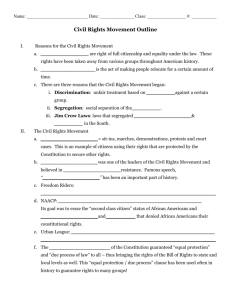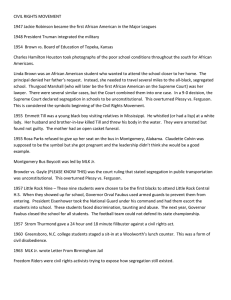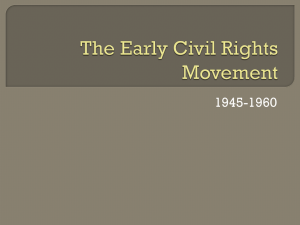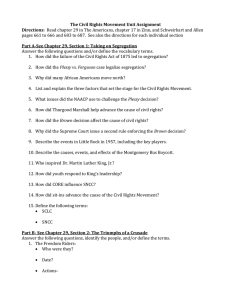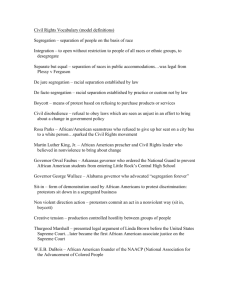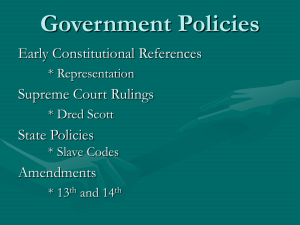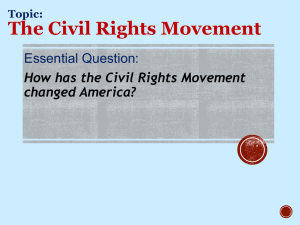Civil Rights - Franklin County Public Schools
advertisement
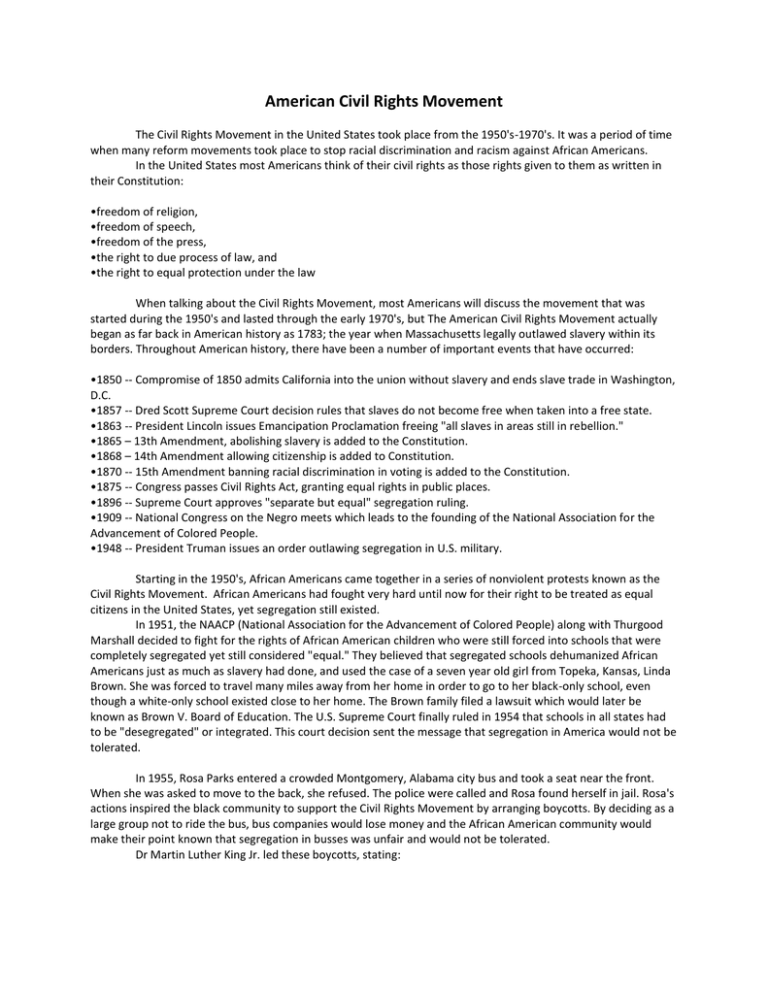
American Civil Rights Movement The Civil Rights Movement in the United States took place from the 1950's-1970's. It was a period of time when many reform movements took place to stop racial discrimination and racism against African Americans. In the United States most Americans think of their civil rights as those rights given to them as written in their Constitution: •freedom of religion, •freedom of speech, •freedom of the press, •the right to due process of law, and •the right to equal protection under the law When talking about the Civil Rights Movement, most Americans will discuss the movement that was started during the 1950's and lasted through the early 1970's, but The American Civil Rights Movement actually began as far back in American history as 1783; the year when Massachusetts legally outlawed slavery within its borders. Throughout American history, there have been a number of important events that have occurred: •1850 -- Compromise of 1850 admits California into the union without slavery and ends slave trade in Washington, D.C. •1857 -- Dred Scott Supreme Court decision rules that slaves do not become free when taken into a free state. •1863 -- President Lincoln issues Emancipation Proclamation freeing "all slaves in areas still in rebellion." •1865 – 13th Amendment, abolishing slavery is added to the Constitution. •1868 – 14th Amendment allowing citizenship is added to Constitution. •1870 -- 15th Amendment banning racial discrimination in voting is added to the Constitution. •1875 -- Congress passes Civil Rights Act, granting equal rights in public places. •1896 -- Supreme Court approves "separate but equal" segregation ruling. •1909 -- National Congress on the Negro meets which leads to the founding of the National Association for the Advancement of Colored People. •1948 -- President Truman issues an order outlawing segregation in U.S. military. Starting in the 1950's, African Americans came together in a series of nonviolent protests known as the Civil Rights Movement. African Americans had fought very hard until now for their right to be treated as equal citizens in the United States, yet segregation still existed. In 1951, the NAACP (National Association for the Advancement of Colored People) along with Thurgood Marshall decided to fight for the rights of African American children who were still forced into schools that were completely segregated yet still considered "equal." They believed that segregated schools dehumanized African Americans just as much as slavery had done, and used the case of a seven year old girl from Topeka, Kansas, Linda Brown. She was forced to travel many miles away from her home in order to go to her black-only school, even though a white-only school existed close to her home. The Brown family filed a lawsuit which would later be known as Brown V. Board of Education. The U.S. Supreme Court finally ruled in 1954 that schools in all states had to be "desegregated" or integrated. This court decision sent the message that segregation in America would not be tolerated. In 1955, Rosa Parks entered a crowded Montgomery, Alabama city bus and took a seat near the front. When she was asked to move to the back, she refused. The police were called and Rosa found herself in jail. Rosa's actions inspired the black community to support the Civil Rights Movement by arranging boycotts. By deciding as a large group not to ride the bus, bus companies would lose money and the African American community would make their point known that segregation in busses was unfair and would not be tolerated. Dr Martin Luther King Jr. led these boycotts, stating: "We are tired...of being segregated and humiliated... For many years we have shown amazing patience...But we come here tonight to be saved from that patience that makes us patient with anything less than freedom and justice." King believed that peacefully fighting segregation was the right thing to do, and for more than a year African Americans continued to boycott the bus. In 1956, a ruling by the Supreme Court finally ended segregated seating on busses throughout the country. In 1960, four students from a black college sat down at the "whites only" section of a lunch counter in Greensboro, North Carolina. The waitress did not know how to react. She did not take their order so the students sat there until the restaurant closed. This began a series of sit-ins across restaurants in the South. People reacted in many different ways to these protests. Some protesters were threatened with violence, food was dumped over their heads, and some were arrested. These sit-ins led to "wade-ins" at public swimming pools, "kneel-ins" at segregated all-white churches, as well as demonstrations in front of department stores and movie theatres. The protesters found it difficult to remain peaceful and courteous especially since white crowds seemed to grow increasingly angry and more violent. The protesters found their strength within the spirit of brotherly love and within their belief that their nonviolent protests were the only way to fight for their freedom. In 1963, a march was planned on Washington D.C. to focus on the need to pass the Civil Rights Bill. Leaders also felt as though it was a good time to tell the government how little it had done to end segregation. Led by Dr. Martin Luther King Jr., over 250,000 people gathered to walk in organized, orderly groups toward the Lincoln Memorial. It was at this march where protestors heard King's famous "I Have a Dream" speech in which he stated, "I have a dream that one day this nation will rise up and live out the true meaning of its creed, 'We hold these truths to be self-evident, that all men are created equal.'" This became one of the largest civil rights demonstrations in the history of the United States. In 1965, Dr. King Jr. organized a march from Selma to Montgomery Alabama, to protest how black voters were being treated. Almost 30,000 black and white Americans joined together to demonstrate the unfairness of forcing blacks to have to pay a tax to vote, or having to face harassment that would prevent them from voting. As a result, the Voting Rights Act was passed that year, and made a huge difference in just one year. By 1966, 60% of African Americans were registered to vote and also were starting to be elected to offices and positions within the government. After nearly 100 years since the end of the Civil War, the American people and its government had finally ended legal segregation. All the laws that allowed the separation between white and black Americans no longer existed. Citations "Birth of a Movement." Kids Discover. 16 March 2008: pages 6 and 7. "The Civil Rights Movement." CNN Interactive. 1997. Cable News Network, Inc. 16 Mar. 2008 <http://www.cnn.com/EVENTS/1997/mlk/links.html>. King, Casey and Linda Barrett Osborne. Oh, Freedom! New York: Alfred A. Knopf Inc., 1997. "The Rise of Segregation." Kids Discover. 16 March 2008: pages 4 and 5. "We Shall Overcome." Kids Discover. 16 March 2008: pages 2 and 3.
